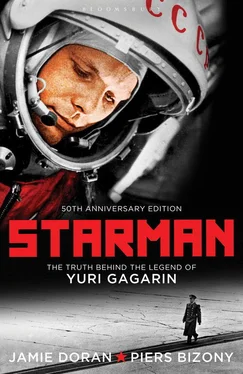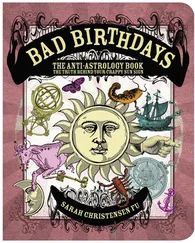Gagarin developed a very good relationship with Russayev, and each man worked behind the scenes to protect the other. Today Russayev says, ‘Yuri was a very pure-hearted man, often taking responsibility for problems caused by others. As for Gherman Titov, problems seemed to slide past him like water off a duck’s back. After his flight he had 20 or more serious disciplinary incidents, car crashes or whatever. People always wanted to connect these problems to Yuri, and at that point I would intervene.’
Russayev (and his colleague Belikov, an excellent linguist) sat close to Gagarin while he made presentations or spoke to journalists. ‘I wasn’t like the bodyguards; I was more an advisor and assistant. You have to imagine all the difficulties Yuri came across in his public life, and on the foreign trips. It was my job to look after him.’ Not that Gagarin was socially inept – far from it. ‘He had an excellent memory for the names of all the politicians and officials he met, quite unlike Kamanin, who came on many of the trips and was hopeless at that kind of thing… Often Yuri could play it by ear, and didn’t need guidance. I was amazed at how he could cope with so many difficult questions.’
Russayev tells a touching story. ‘Nikita Sergeyevich Khrush chev could get pretty tipsy on just a couple of glasses of booze, and Yura always protected him from going over the top.’ Although Gagarin quite obviously adored Khrushchev, he kept as far apart from other politicians as he could safely manage without giving offence. Sergei Belotserkovsky came to know Gagarin very well, tutoring him in aerospace studies from 1964 onwards, when Gagarin was trying to get back to serious work. ‘I think his personality began to split. On one side he was the welcome guest of kings, presidents and even the Queen of England, but on the other side he never lost his ties with the ordinary people. I think he began to sense the lower classes’ lack of rights, their hardship, and he saw the corruption of the top layers of society. He saw our drunken leaders dancing on the table and behaving badly, and that can’t have left his honest soul unwounded. I’m talking not just about the external symptoms, but also the internal corruption which was dominant among our top leadership clan.’
Quite unfairly, there was a certain degree of resentment directed at Gagarin because of all the privileges he was assumed to have accumulated under Khrushchev. True, he and the other cosmonauts were given better-than-average living accommodation, but their level of comfort was not significantly better than that of most middle-ranking officers. Titov says, ‘Honestly, we never received special benefits. People were always saying to me, “Show us, point to the place where you’d like your luxury dacha to be, and Khrushchev will build it for you straight away.” I didn’t bother, and neither did Yuri. We were just young men. What were they talking about? What did we want with dachas ?’
Russayev confirms this. ‘Yuri was a completely honest guy. He was the first cosmonaut in space, he did so much for his country, and you should see the place that Valya lives in today. Instead of a decent dacha , it’s a hen-house. Yuri worked hard for the good of his native land, not for his own wealth.’ [5] Venyamin Russayev agreed to be interviewed when Valentina Gagarina suggested he should do so. Valentina no longer gives interviews herself.
Inevitably there were darker jealousies working against Gagarin’s peace of mind, and not just about the material fringe benefits that he was assumed to be enjoying. Sergei Belotserkovsky observes, ‘Even Korolev couldn’t have anticipated the avalanche of problems that would hit Gagarin when he had to represent his country abroad. He made many enemies because he behaved with more charm, and could talk more wisely and honestly, than the official Soviet heads of foreign delegations. Superiors never forgive you for something like that.’
Russayev worked hard to protect Gagarin from such dangers. ‘He always said that politics seemed hard and intricate. I told him, “Politics is a dirty business. You should stay out of it. You’ve got your country, your family. Enjoy what you’ve got, and don’t get involved in the politics.”’
Russayev remained with Gagarin until 1964, when Khrushchev’s administration was toppled by Leonid Brezhnev. After that, the KGB’s relationship with all the cosmonauts would become very different. In March 1967 Gagarin would turn to Russayev one last time for some much-needed political guidance. By then it would be too late in the day for both of them.
To their mutual surprise, Russian and American space medical experts had discovered by 1963 that the hardships of flight into space amounted to no more than a collection of minor irritations: nausea, vertigo, a heavy feeling in the head, a dryness in the throat. All these symptoms were uncomfortable, but any conventionally fit human could survive a trip into orbit. From now on the emphasis was on training not just the right bodies, but the right minds and intellects for working aboard an ever more complex succession of spacecraft. Korolev, Kamanin and other senior figures in the Soviet manned rocket programme re-examined the personal files of sixteen promising cosmonaut candidates previously rejected by the medical boards in 1959. They decided to give them another chance, because their engineering and academic skills were now regarded as more important than extreme physical fitness. By May 1964 this fresh cosmonaut squad had been supplemented with ten non-pilot technical specialists from within the space community itself. They were, in fact, talented engineers from within Korolev’s OKB-1 design bureau. Meanwhile most of Gagarin’s old friends and colleagues from the original 1959 group of twenty, including Gherman Titov, Alexei Leonov, Vladimir Komarov and Andrian Nikolayev, were studying very hard to maintain their superiority over the twenty-six newcomers. [1] Hooper, The Soviet Cosmonaut Team , Vol. I, pp. 33–6.
On December 21, 1963 Colonel Gagarin was appointed Deputy Director of the Cosmonaut Training Centre, reporting directly to Nikolai Kamanin. To a large extent this new job was a means of promoting him without putting him in harm’s way. During the last three years he had fallen behind in every aspect of space training, and he had not been allowed to fly jet fighters because of the risks involved. Unlike a normal combat pilot, he was not expendable, but had to be preserved in one piece as a diplomatic and social symbol; even if he had been able to return to space-flight status at a moment’s notice, the qualities that had made him so ideal for Vostok were no longer so important. It was not enough just to be a fit young pilot with the right attitude and background. If Yuri wanted to board a spacecraft again he would have to study orbital mechanics, flight systems, computer control and space navigation, then convince his superiors to put him back on the ‘active’ flight list. Korolev certainly wanted him back in the fold, but he had long ago warned his favourite ‘little eagle’ that he would have to get back into academic training as soon as possible.
As far back as June 1962 the Chief Designer had lost patience with the endless foreign trips and had complained, ‘We’re losing Gagarin and Titov as far as space is concerned.’ He criticized Kamanin for failing to look after them properly. As so often, Kamanin deflected his own faults onto others, noting in his diary, ‘Looking into his complaints, one can see Korolev’s bitterness at having to keep his name under cover.’ [2] Kamanin’s diaries, June 22, 1962.
Korolev was already thinking beyond Voskhod, with plans for an ambitious new spacecraft capable of extraordinary feats: changing its orbit on command, adjusting its pitch and yaw attitude with millimetre accuracy and, most startling of all, making a rendezvous with another craft and docking with it to form a larger aggregate assembly. The new spacecraft was to be called ‘Soyuz’, meaning ‘Union’. Of course this was a direct response to America’s Apollo ship. In fact, Soyuz’s general layout, with a rear equipment section, a re-entry capsule in the middle, and a dropaway docking compartment at the front, seemed suspiciously similar to an early proposal for Apollo drawn up by the General Electric Company in a failed bid to win a NASA contract.
Читать дальше












